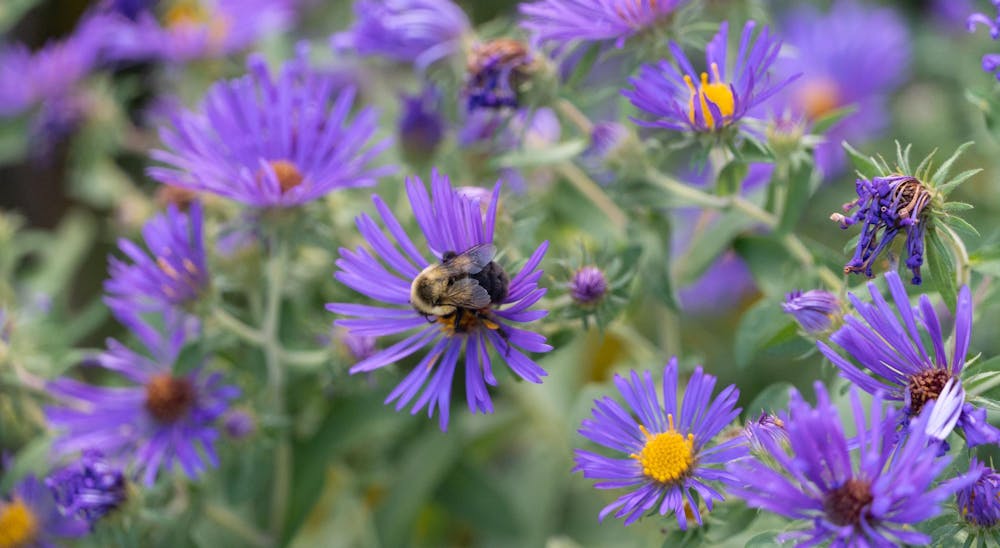Returning to campus in the fall, it’s hard to ignore the ways campus has changed as Princeton reshapes itself. Most striking is the transformation that has occurred just outside the windows of Yeh College and New College West. Where there were once only low grasses and daffodils, now sprout black-eyed Susan, New England aster and goldenrod. Skies are now filled with swarms of bumblebees and warblers. The southern edge of campus has been transformed into a mini-meadow, able to house many new insects frolicking alongside the undergrads beginning the fall semester.
These improvements are a credit to the many staff members at Princeton who worked to plan and implement them, and their efforts should be celebrated. Still, there is much work left to be done. According to Princeton University Facilities, the University aims to have 85 percent of plants in its landscape be native to the mid-Atlantic region. But 85 percent isn't enough — the University must continue to expand its re-nativizing efforts beyond new construction, bringing native species to the whole campus.
Princeton’s social media team loves to emphasize the beauty of upper campus, especially in the many Instagram posts of Alexander Beach and other quads showing off stately trees and carefully pruned bushes lording over carefully mowed lawns. But there’s something sterile about this landscape. Too many open spaces consist of isolated trees awash in an ocean of lawn grass. Only the occasional carefully pruned bush breaks up the monotony.
As a result, the plants feel like props; a nice backdrop for quinceañera or wedding photos rather than parts of a living ecological community. Landscaping should not merely serve an aesthetic purpose — a visual accentuation to our collegiate-gothic architecture — but a practical one. Great landscaping must interface with its natural location. Princeton’s pristinely manicured lawns seek to assert dominion over nature rather than foster an organic and compatible relationship with the surrounding environment.
Interfacing honestly with the natural world begins by replacing non-native ornamental plants with ones that are native to the mid-Atlantic region. Native plants have the advantage of needing less water, fertilizers, and pesticides compared to non-natives. They also serve as a better food source for the insects that have evolved to eat them, insects that in turn serve as food sources for birds and species at higher trophic levels. Dr. Douglas Tallamy of the University of Delaware found that native oak trees could support 557 species of caterpillars whereas non-native ginkgo trees (a common sight on campus) supported almost none. As a result, these planting decisions have enormous cascading effects at every trophic level, greatly impacting the size and diversity of animal populations in our region.
Princeton's goal of planting 85 percent native plants is admirable, but the model that they’ve so far followed upcampus — planting a few sparse native ornamentals — fails to live up to our campus’ potential to create a working network of interacting communities. Lonely trees and shrubs that are planted in isolation from one another cannot provide the same benefit as a truly interconnected landscape capable of supporting a variety of wildlife. This means replacing some non-native grassy fields and patches of invasive ivy with the same sort of mix of native grasses and wildflowers currently growing around Yeh and NCW.
Princeton should construct such landscapes with the intent of achieving specific environmental goals. For example, Princeton could support native insects by either planting nectar-heavy flowers to attract pollinators or by planting ‘keystone’ species such as goldenrod that can play host to a large number of caterpillar species and serve as the sole host for a species. Native grasses are also excellent at retaining water, a feature that can be used to build rain gardens to help deal with excess runoff from buildings. These straightforward practices can have a substantial impact on the campus environment.
Publicly embracing such a comprehensive approach to landscaping can also benefit Princeton’s educational mission. A large majority of people are ‘plant blind,’ unable to see or notice plants in their own surroundings. This leads to a dearth of attention on plant-related conservation issues, to the detriment of us all.

Increasing awareness of the key roles that specific plant species play in supporting biodiversity is of great importance. Many people understand that plants are a crucial element in the fight against climate change, but specifics matter: the kinds of plants we choose to grow have a larger effect than just the quantity itself. Princetonians should be able to tell the difference between a sugar maple and a Norway maple, considering that one is an iconic feature of the forests of the northeastern United States and the other is an invasive pest characterized by its ability to suppress wildflower growth.
If we want to solve the biodiversity crisis, we need to think carefully about the kinds of plants we choose to grow. By creating and explaining its vision for an interconnected landscape of gardens filled with food for pollinators and habitat for insects, the University can inspire students, faculty, staff, or anyone visiting campus to consider what they can do to create a better habitat for their local fauna. Local action is essential to reversing the devastating habitat loss that has decimated wildlife populations in North America. Princeton has an opportunity to take the lead by changing how we manage our landscapes. It should take it.
Thomas Buckley is a sophomore from Colchester, Vermont planning to major in economics. A contributing columnist for the ‘Prince,’ he can be reached at thomas.buckley@princeton.edu









